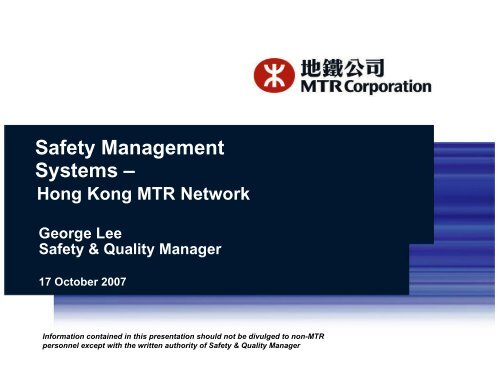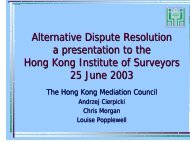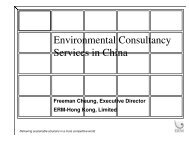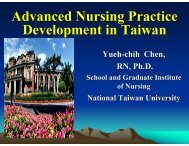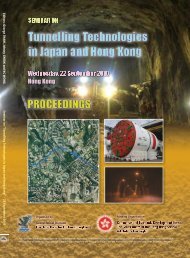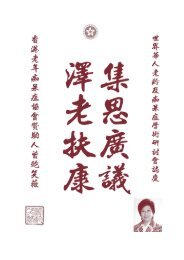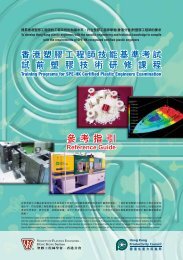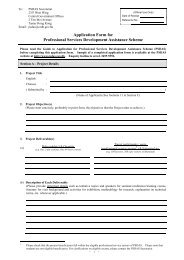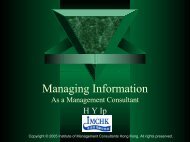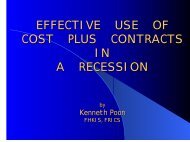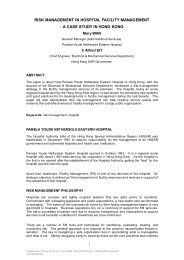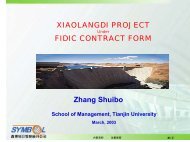Safety Management Systems - Hong Kong MTR Network
Safety Management Systems - Hong Kong MTR Network
Safety Management Systems - Hong Kong MTR Network
Create successful ePaper yourself
Turn your PDF publications into a flip-book with our unique Google optimized e-Paper software.
<strong>Safety</strong> <strong>Management</strong><br />
<strong>Systems</strong> –<br />
<strong>Hong</strong> <strong>Kong</strong> <strong>MTR</strong> <strong>Network</strong><br />
George Lee<br />
<strong>Safety</strong> & Quality Manager<br />
17 October 2007<br />
Information contained in this presentation should not be divulged to non-<strong>MTR</strong><br />
personnel except with the written authority of <strong>Safety</strong> & Quality Manager<br />
<strong>MTR</strong> Corporation Limited 19/03/2007 Page 1
Outline of Presentation<br />
1. Development of <strong>MTR</strong> : 1979 - 2006<br />
2. Development of <strong>Safety</strong> <strong>Management</strong> & Key<br />
Drivers for Change<br />
3. Integration of <strong>Safety</strong> <strong>Management</strong> with<br />
Corporate <strong>Systems</strong><br />
4. <strong>Safety</strong> Performance<br />
5. Conclusions<br />
<strong>MTR</strong> Corporation Limited 17/10/2007 Page 2
1. Development of <strong>MTR</strong> : 1979 - 2006<br />
<strong>MTR</strong> Corporation Limited 17/10/2007 Page 3
Overview of <strong>MTR</strong> Establishment<br />
• <strong>MTR</strong> Provisional Authority<br />
• Mass Transit Railway Corporation<br />
(1975)<br />
(1977)<br />
• Statutory Body<br />
-100% owned by <strong>Hong</strong> <strong>Kong</strong><br />
Government<br />
• Operating under<br />
“prudent commercial principles”<br />
• Privatization / Public Listing<br />
(2000)<br />
<strong>MTR</strong> Corporation Limited 17/10/2007 Page 4
Development of Railway – MIS<br />
(opened in Oct 1979)<br />
Route Km<br />
15.6<br />
Daily Patronage<br />
950,809<br />
<strong>MTR</strong> Corporation Limited 17/10/2007 Page 5
Development of Railway – TWE<br />
(opened in May 1982)<br />
Route Km<br />
10.5<br />
Daily Patronage<br />
717,623<br />
<strong>MTR</strong> Corporation Limited 17/10/2007 Page 6
Development of Railway – ISL Route Km<br />
(opened in May 1985)<br />
12.5 791,623<br />
Daily Patronage<br />
<strong>MTR</strong> Corporation Limited 17/10/2007 Page 7
Development of Railway – EHC Route Km<br />
(opened in Aug 1989)<br />
4.6<br />
87,751<br />
Daily Patronage<br />
<strong>MTR</strong> Corporation Limited 17/10/2007 Page 8
Development of Railway – LAR Route Km<br />
(opened in Jun 1998)<br />
TCL – 30.8 308,326<br />
AIR – 34.8<br />
Daily Patronage<br />
243,870<br />
<strong>MTR</strong> Corporation Limited 17/10/2007 Page 9
Development of Railway – TKE Route Km<br />
(opened in Aug 2002)<br />
12.5 314,362<br />
Daily Patronage<br />
Route Km<br />
Daily Patronage<br />
97,752<br />
<strong>MTR</strong> Corporation Limited 17/10/2007 Page 10
Development of Railway – DRL Route Km<br />
(opened in Sept 2005)<br />
3.4<br />
97,752<br />
Daily Patronage<br />
<strong>MTR</strong> Corporation Limited 17/10/2007 Page 11
<strong>MTR</strong> Railway <strong>Systems</strong> & Equipment<br />
• A railway network of 91 km route<br />
• 1500 volt d.c. overhead power supply<br />
• EMU<br />
‣ 8-car train (length of each Urban Line train : 182<br />
metres)<br />
‣ 2,500 passengers / train<br />
<strong>MTR</strong> Corporation Limited 17/10/2007 Page 12
<strong>MTR</strong> Railway <strong>Systems</strong> & Equipment,<br />
continued<br />
• Tunnel ventilation<br />
• Platform screen doors<br />
<strong>MTR</strong> Corporation Limited 17/10/2007 Page 13
<strong>MTR</strong> Railway <strong>Systems</strong> & Equipment,<br />
continued<br />
• To ensure maximum safety &<br />
reliability, trains are operated with<br />
automatic control & protection<br />
systems (i.e. ATP, ATO, ATR)<br />
which<br />
‣ Regulate the distance between<br />
trains<br />
‣ Determine the optimal rates of<br />
acceleration & braking as well<br />
as the coasting speeds on<br />
different sections of the track<br />
<strong>MTR</strong> Corporation Limited 17/10/2007 Page 14
Current <strong>MTR</strong> <strong>Network</strong><br />
7 7 lines; 91 91 km km route route length; length; 53 53<br />
stations<br />
<br />
<br />
<br />
Providing 19 19 hours hours of of passenger<br />
passenger service daily service from daily 6 a.m. from to 61<br />
a.m. a.m. to 1 a.m.<br />
During<br />
During<br />
morning<br />
morning<br />
peak<br />
peak<br />
hours,<br />
hours,<br />
trains running at 2-minute<br />
trains running at 2-minute<br />
intervals<br />
intervals<br />
<br />
<strong>MTR</strong> keeps 2.5 million people on the move<br />
every weekday<br />
Operations Control Centre<br />
<strong>MTR</strong> Corporation Limited 17/10/2007 Page 15
<strong>MTR</strong> Corporation Today<br />
• No. of staff : 6,639<br />
• Asset value : US$15,439 M<br />
• 2006 P & L<br />
Turnover<br />
Profit<br />
: US$1,223 M<br />
: US$995 M<br />
• No. of properties<br />
developed : 25<br />
• No. of flats : 58,876<br />
• No. of retail malls : 6<br />
• Commercial &<br />
office space : 582,073m 2<br />
<strong>MTR</strong> Corporation Limited 17/10/2007 Page 16
2. Development of <strong>Safety</strong><br />
<strong>Management</strong> & Key Drivers for Change<br />
<strong>MTR</strong> Corporation Limited 17/10/2007 Page 17
The initial stages of safety management<br />
development focused on our railway<br />
operations<br />
<strong>MTR</strong> Corporation Limited 17/10/2007 Page 18
Overview of <strong>Safety</strong> <strong>Management</strong> Development in <strong>MTR</strong><br />
Date<br />
1979 - 1989<br />
Stage 1<br />
1990 - 1994 1995 - 2003 2004 - 2006<br />
Stage 2 Stage 3<br />
Stage 4<br />
System<br />
• Rule Book<br />
• Compliance Based<br />
• Expatriate Focus<br />
• Engineering<br />
Standards<br />
• <strong>Safety</strong><br />
<strong>Management</strong><br />
System<br />
• Risk Based<br />
Approach<br />
• <strong>Safety</strong><br />
Communication<br />
• <strong>Safety</strong> Culture<br />
• Integrated<br />
<strong>Management</strong><br />
System<br />
• System Assurance<br />
• Whole Project Life<br />
Risk<br />
• Enterprise Risk<br />
<strong>Management</strong><br />
• Human Factors<br />
<strong>Management</strong><br />
• Corporate <strong>Safety</strong><br />
Governance<br />
• Business<br />
Excellence Models<br />
Drivers<br />
‣ Lack of HK<br />
Experience<br />
‣ Lack of National<br />
Standards<br />
‣ Low Social<br />
Expectation …<br />
‣ King’s Cross<br />
‣ Clapham<br />
‣ External<br />
Benchmarking<br />
‣ External <strong>Safety</strong><br />
Mgt Review …<br />
‣ Development of<br />
Other Mgt <strong>Systems</strong><br />
‣ TQM & National<br />
Quality Awards<br />
‣ Cyber Info Mgt<br />
‣ Public Listing<br />
‣ Growth Strategy<br />
‣ Need for<br />
Breakthrough<br />
Business<br />
Performance …<br />
Culture of <strong>Safety</strong> Awareness<br />
<strong>MTR</strong> Corporation Limited 17/10/2007 Page 19
Stage 1 – Development of <strong>Safety</strong> <strong>Management</strong><br />
• Based on LUL / BR Rule Book<br />
• Strong reliance on discipline<br />
• “Top-down” communication<br />
• Reliance on key individuals –<br />
many of them expatriates with<br />
consequential communication<br />
problems<br />
• Significant improvement on<br />
existing public transport (i.e.<br />
buses, trams, KCR)<br />
System<br />
Drivers<br />
1979 - 1989<br />
Stage 1<br />
• Rule Book<br />
• Compliance Based<br />
• Expatriate Focus<br />
• Engineering<br />
Standards<br />
‣ Lack of HK<br />
Experience<br />
‣ Lack of National<br />
Standards<br />
‣ Low Social<br />
Expectation …<br />
<strong>MTR</strong> Corporation Limited 17/10/2007 Page 20
Stage 2 – Development of <strong>Safety</strong><br />
<strong>Management</strong><br />
• Process of arriving at <strong>Safety</strong><br />
<strong>Management</strong> System based on<br />
recommendation of Arthur D Little<br />
Review Report in 1992<br />
• Formulation of <strong>Safety</strong> Policy & <strong>Safety</strong><br />
Tasks and development of <strong>Safety</strong><br />
Responsibilities<br />
• Establishment of a <strong>Safety</strong> Services<br />
Dept with expertise in Risk<br />
<strong>Management</strong>, <strong>Safety</strong> Audit, <strong>Safety</strong><br />
Advice, <strong>Safety</strong> Training & Promotion<br />
and Occupational Health<br />
• Definition of “<strong>Safety</strong>” functions as line<br />
management’s responsibility<br />
System<br />
Drivers<br />
<strong>MTR</strong> Corporation Limited 17/10/2007 Page 21<br />
1990 - 1994<br />
Stage 2<br />
• <strong>Safety</strong><br />
<strong>Management</strong><br />
System<br />
• Risk Based<br />
Approach<br />
• <strong>Safety</strong><br />
Communication<br />
• <strong>Safety</strong> Culture<br />
‣ King’s Cross<br />
‣ Clapham<br />
‣ External<br />
Benchmarking<br />
‣ External <strong>Safety</strong><br />
Mgt Review …
Stage 3 – Development of <strong>Safety</strong><br />
<strong>Management</strong><br />
• Different management systems<br />
on safety, quality, environmental,<br />
security & asset management<br />
requirements running separately<br />
could undermine our<br />
organizational efficiency, costeffectiveness<br />
and sustainability<br />
• A world-class enterprise like <strong>MTR</strong><br />
should apply TQM principles &<br />
criteria of other National Quality<br />
Awards<br />
System<br />
Drivers<br />
1995 - 2003<br />
Stage 3<br />
• Integrated<br />
<strong>Management</strong><br />
System<br />
• System Assurance<br />
• Whole Project Life<br />
Risk<br />
‣ Development of<br />
Other Mgt <strong>Systems</strong><br />
‣ TQM & National<br />
Quality Awards<br />
‣ Cyber Info Mgt<br />
<strong>MTR</strong> Corporation Limited 17/10/2007 Page 22
Stage 3 – Development of <strong>Safety</strong> <strong>Management</strong>,<br />
cont’d<br />
• With the help of intranet hyperlink<br />
technology and cyber information &<br />
documentation management tools,<br />
online single-page Procedures &<br />
Work Instructions were made<br />
possible<br />
System<br />
1995 - 2003<br />
Stage 3<br />
• Integrated<br />
<strong>Management</strong><br />
System<br />
• System Assurance<br />
• Whole Project Life<br />
Risk<br />
• An Integrated <strong>Management</strong> System<br />
covering safety, quality,<br />
environmental and security<br />
management requirements was<br />
developed and implemented in the<br />
Operations Division of <strong>MTR</strong> in 2000<br />
Drivers<br />
‣ Development of<br />
Other Mgt <strong>Systems</strong><br />
‣ TQM & National<br />
Quality Awards<br />
‣ Cyber Info Mgt<br />
• Development of system assurance<br />
<strong>MTR</strong> Corporation Limited 17/10/2007 Page 23
Stage 4 – Development of <strong>Safety</strong><br />
<strong>Management</strong><br />
• Through Enterprise Risk<br />
<strong>Management</strong>, the key risks in<br />
<strong>MTR</strong>’s business were identified<br />
and addressed<br />
• In line with growth business,<br />
adequate controls are put in place<br />
to strengthen Corporate <strong>Safety</strong><br />
Governance<br />
• Need for breakthrough<br />
improvement in quality & business<br />
performance via Six Sigma<br />
methodology<br />
System<br />
Drivers<br />
<strong>MTR</strong> Corporation Limited 17/10/2007 Page 24<br />
2004 - 2006<br />
Stage 4<br />
• Enterprise Risk<br />
<strong>Management</strong><br />
• Human Factors<br />
<strong>Management</strong><br />
• Corporate <strong>Safety</strong><br />
Governance<br />
• Business<br />
Excellence Models<br />
‣ Public Listing<br />
‣ Growth Strategy<br />
‣ Need for<br />
Breakthrough<br />
Business<br />
Performance …
<strong>MTR</strong> <strong>Safety</strong> <strong>Management</strong> System (SMS) -<br />
Purpose<br />
• The purpose of the <strong>Safety</strong> <strong>Management</strong> System is to<br />
provide a workable framework for managing safety in<br />
a systematic, proactive and consistent manner, so<br />
that the <strong>Safety</strong> Policy can be effectively implemented<br />
• It allows management to manage safety<br />
systematically like all other critical aspects of the<br />
business<br />
• It reduces the need for “safety experts” as safety<br />
management then becomes line management’s<br />
responsibility<br />
• All staff involved can talk on safety using the same<br />
language<br />
<strong>MTR</strong> Corporation Limited 17/10/2007 Page 25
<strong>Safety</strong> Policy<br />
<br />
CLIMATE OF SAFETY AWARENESS<br />
<br />
GOAL SETTING approach for<br />
continuous improvement<br />
<br />
<strong>Safety</strong> demands ACTIVE involvement by<br />
all<br />
<br />
<strong>Safety</strong> management is<br />
LINE MANAGEMENT’S<br />
RESPONSIBILITY<br />
<strong>MTR</strong> Corporation Limited 17/10/2007 Page 26
SMS – Key Components<br />
<strong>Safety</strong> Policy<br />
<strong>Safety</strong> Tasks<br />
and <strong>Safety</strong><br />
Modules<br />
<strong>Safety</strong><br />
<strong>Management</strong><br />
Process<br />
Staff Consultation<br />
SMS<br />
<strong>Safety</strong><br />
Responsibility<br />
Statements /<br />
Cards<br />
<strong>Safety</strong> Audit<br />
System<br />
<strong>Safety</strong> Committees<br />
<strong>Safety</strong> Critical<br />
Items /<br />
<strong>Systems</strong><br />
Risk Control<br />
System<br />
<strong>MTR</strong> Corporation Limited 17/10/2007 Page 27
Strategic approach to achieving a climate of safety<br />
awareness<br />
• Demonstrating commitment through leadership<br />
• Assigning safety responsibility to individuals and<br />
ensuring their effective discharge<br />
• Managing the competence of staff, contractors and<br />
other business partners to ensure they deliver safety in<br />
all activities<br />
• Maintaining safety communication with stakeholders<br />
and at all levels of each business<br />
• Promoting a progressive safety culture and involving<br />
staff in safety improvements<br />
<strong>MTR</strong> Corporation Limited 17/10/2007 Page 28
Strategic approach to achieving continuous<br />
improvement in safety performance<br />
• Using recognized modern practices and processes<br />
appropriate to each business<br />
• Establishing and operating a risk management system<br />
appropriate to each business<br />
• Implementing management systems to reduce risk to<br />
reasonably low level<br />
• Measuring and communicating safety performance<br />
• Maintaining an inspection and audit programme<br />
• Providing the necessary funding and resources<br />
• Continuously reviewing our approach to managing<br />
safety<br />
• Learning from incidents in other organizations in the<br />
relevant sectors to improve our own safety<br />
<strong>MTR</strong> management<br />
Corporation Limited 17/10/2007 Page 29
Risk Assessment & <strong>Management</strong><br />
• <strong>MTR</strong> Risk Matrix<br />
<strong>Safety</strong> criticality R1 to R4<br />
to quantify the risk level of<br />
the identified risk<br />
• RCPI<br />
(Risk Control<br />
Performance Index) to<br />
keep track of risk profile<br />
of the railway<br />
No. of R1/R2 Hazarads<br />
120<br />
100<br />
80<br />
60<br />
40<br />
20<br />
0<br />
Trend of Risk Control Performance Index and<br />
no. of R1/R2 hazards<br />
Jan-99 Jan-00 Jan-01 Jan-02 Jan-03 Jan-04 Jan-05 Jan-06<br />
800<br />
700<br />
600<br />
500<br />
RCPI value<br />
400<br />
300<br />
200<br />
100<br />
0<br />
No. of R1 Hazards No. of R2 Hazards RCPI<br />
<strong>MTR</strong> Corporation Limited 17/10/2007 Page 30
<strong>Safety</strong> Responsibilities of the Executive<br />
• Provide leadership and exercise corporate governance<br />
in safety and health<br />
• Ensure all Executive decisions reflect the intent and<br />
spirit of the Corporate <strong>Safety</strong> Policy<br />
• Establish a Corporate <strong>Safety</strong> Committee to lead the<br />
dissemination and implementation of the Corporate<br />
<strong>Safety</strong> Policy and Strategy<br />
• Review and approve the annual Corporate <strong>Safety</strong> Plan<br />
• Ensure the necessary organization and other<br />
arrangements are in place to support the achievement<br />
of the Corporate <strong>Safety</strong> Plan and related goals<br />
• Monitor safety performance and risk profiles<br />
<strong>MTR</strong> Corporation Limited 17/10/2007 Page 31
<strong>Safety</strong> Responsibilities of Staff<br />
• All Staff<br />
‣ Understand and fully discharge the safety and health<br />
responsibilities pertaining to their job<br />
‣ Observe the provision of safety rules and regulations,<br />
act safely and report hazards and dangerous<br />
occurrences<br />
• Managers and Supervisors<br />
‣ Managing safety is line management’s responsibility<br />
‣ Must proactively ensure the systems, people,<br />
processes, materials and environments within their<br />
jurisdiction are managed in a systematic and effective<br />
manner to reduce safety risks to reasonably low level<br />
<strong>MTR</strong> Corporation Limited 17/10/2007 Page 32
Managing <strong>Safety</strong> – from Committee to the<br />
individual<br />
• Operations <strong>Safety</strong> Committee sets policy & strategy<br />
• Five sub-committees<br />
• Line management is directly responsible for safety<br />
• <strong>Safety</strong> & Quality Department provides advice and support,<br />
facilitates and carries out audits<br />
• At least one item in the individual’s Key Objectives should<br />
be safety-related<br />
• <strong>Safety</strong> Responsibility Statement / Card for everybody<br />
<strong>MTR</strong> Corporation Limited 17/10/2007 Page 33
<strong>Safety</strong> Communication & Promotion<br />
• <strong>Safety</strong> is a standing agenda item in line management<br />
meetings at all levels<br />
• Regular safety briefings and pre-work safety talks are<br />
held for different work teams<br />
• <strong>Safety</strong> topics are discussed regularly at Divisional level<br />
communications<br />
• Compulsory agenda item for Staff Consultative Council<br />
(SCC) and Joint Consultative Committees (JCCs)<br />
<strong>MTR</strong> Corporation Limited 17/10/2007 Page 34
3. Integration of <strong>Safety</strong> <strong>Management</strong> with<br />
Corporate <strong>Systems</strong><br />
<strong>MTR</strong> Corporation Limited 17/10/2007 Page 35
Operations Division<br />
Integrated<br />
<strong>Management</strong><br />
System<br />
<strong>Safety</strong> Security<br />
Environment<br />
Quality Asset<br />
<strong>MTR</strong> Corporation Limited 17/10/2007 Page 36
SMS – A Critical Part of the Integrated<br />
<strong>Management</strong> System<br />
Driver System Measure Goal<br />
Leadership<br />
System <strong>Management</strong><br />
• Integrated <strong>Management</strong> Review<br />
• Integrated Audit<br />
Policy<br />
Manual<br />
• Mission<br />
• Vision<br />
• Policy<br />
• Objectives<br />
System<br />
Integration<br />
System <strong>Management</strong><br />
Manual<br />
• Quality<br />
• <strong>Safety</strong><br />
• Environmental<br />
•TQM<br />
• Asset <strong>Management</strong><br />
• Project <strong>Management</strong>,<br />
etc.<br />
System<br />
Implementation<br />
Cyber<br />
Information<br />
• Integrated<br />
Procedures<br />
• Work Instructions<br />
• Support<br />
Documents<br />
• Information Mall<br />
Business<br />
Goal<br />
Balanced<br />
Scorecard<br />
Total<br />
Customer<br />
Satisfaction<br />
Customer<br />
Service<br />
Standards<br />
Strategic<br />
<strong>Management</strong><br />
<strong>Systems</strong><br />
Team-driven Organization<br />
• <strong>Management</strong> Committee<br />
• Champion-led Teams<br />
• Continuous Improvement Teams<br />
<strong>MTR</strong> Corporation Limited 17/10/2007 Page 37
Project Life Cycle <strong>Safety</strong> Tasks<br />
Budget<br />
Approval<br />
Particular<br />
Specification<br />
Contract<br />
Award<br />
Release<br />
Certificate<br />
Completion<br />
of Contract<br />
Concept<br />
Definition/<br />
Specification<br />
Tendering<br />
Design,<br />
Development &<br />
Manufacturing<br />
Commissioning/<br />
Warranty<br />
Operation/<br />
Maintenance<br />
Renewal/<br />
Disposal<br />
Initial Risk<br />
Appraisal<br />
Pre-Contract Award Hazard<br />
Identification, Control and<br />
Monitoring<br />
Post-Contract Award Hazard<br />
Identification, Control and<br />
Monitoring<br />
Operations Risk Control<br />
Review of Existing Hazards (if any)<br />
HAZOP/PHA<br />
Project Hazard Log<br />
(high level)<br />
HAZOP/PHA<br />
Project Hazard Log<br />
Residual Hazards<br />
Hazard Review & Audit<br />
<strong>Safety</strong> Report<br />
Hazard Close out<br />
Operations Hazard Log<br />
Consultant / Project Team<br />
Consultant / Contractor<br />
/ Project Team<br />
Operator<br />
<strong>MTR</strong> Corporation Limited 17/10/2007 Page 38
Asset <strong>Management</strong> System in Relation to <strong>Safety</strong><br />
Risk management for<br />
effective asset<br />
management<br />
• Asset service<br />
criticality ranking<br />
• <strong>Safety</strong> risk<br />
management<br />
• Project risk<br />
management<br />
<strong>MTR</strong> Corporation Limited 17/10/2007 Page 39
5. Conclusions<br />
<strong>MTR</strong> Corporation Limited 17/10/2007 Page 40
Conclusions<br />
• <strong>MTR</strong> had, as its foundations, a rule-based safety<br />
system imported from U.K.<br />
• As the railway and the business developed, this<br />
approach was seen to be inadequate<br />
• The <strong>Safety</strong> <strong>Management</strong> System which was<br />
developed was derived from best practices in other<br />
industries and was underpinned by the need to<br />
develop a strong safety awareness & culture across<br />
railway operations<br />
• The current <strong>Safety</strong> <strong>Management</strong> System is<br />
comprehensive, practical and company-wide<br />
(including contractors & suppliers) is fully integrated<br />
with other company management systems and has<br />
delivered excellent results<br />
<strong>MTR</strong> Corporation Limited 17/10/2007 Page 41
Conclusions, continued<br />
• The approach to safety management has been used<br />
as the model for the development of other<br />
management systems, culminating in the Enterprise<br />
Risk <strong>Management</strong> System<br />
• A fundamental strength of the system is the wide<br />
and deep participation of all layers of staff<br />
• The growth of the company outside <strong>Hong</strong> <strong>Kong</strong> and<br />
merger with KCRC present significant challenges to<br />
the evolution of safety management system<br />
<strong>MTR</strong> Corporation Limited 17/10/2007 Page 42
<strong>MTR</strong> Corporation Limited 17/10/2007 Page 43


